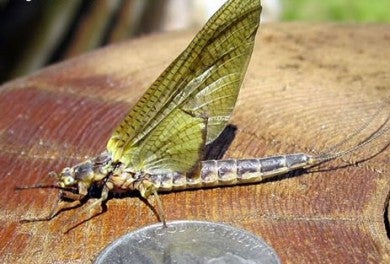Understanding Flies for Walleyes
Bob McNally 03.18.16

While a university degree in entomology isn’t needed by walleye anglers, learning about mayflies and how to differentiate them from “lake flies” is important to capitalize on the feeding binges these vital forage bases trigger in major walleye fisheries.
“There are hundreds of different mayfly species and lots of different ‘lake flies,’ too,” explains Brad Parsons, research supervisor and regional DNR fish manager for Minnesota’s central region. “It’s not uncommon to have several different species of mayflies or lake flies [regionally called ‘fish flies,’ ‘sand flies,’ ‘muckleheads,’ ‘chizzywinks,’ and ‘blind mosquitoes’] living in the same watershed. All of them are very important to walleyes and the habitats in which they live. They are the lifeblood of walleye waters and help make lakes and rivers full of forage for gamefish.”
The biggest of the mayflies, and arguably the most important to walleyes and walleye fishermen, is the well-known Hexagenia group. These are the largest of the mayflies, commonly growing 2-inches or larger in size, in both the fly and the nymph form. They are not only large and offer a pleasing forage target to walleyes, but they also are extremely abundant, with many different species within the Hexagenia group. This includes the Hexagenia limbata, which is one of the most geographically widespread mayflies on the continent, found coast to coast, from Florida to Canada, and is a vital part of the food chain virtually everywhere in lakes and slow-moving rivers.
Perhaps the most important thing to note about the mayfly for a walleye angler is that because mayflies can be so large (as well as their larval nymph form found underwater), when they are abundant, walleyes commonly feed on the insects themselves, not necessarily only upon the small forage fish (perch, shiners) that consume mayflies, too.
Thus imitating mayflies and their nymphs may be productive for walleye fishing, along with using plugs mimicking baitfish feeding on mayflies.
Because “lake flies” are considerably smaller, when they hatch in abundance, walleye anglers may be better off using plugs imitating baitfish feeding on insects.
A “lake fly” is actually midge, or more properly known by the scientific name of chironomid, and there are hundreds of varieties of these comparatively small flies occurring almost everywhere there is water. When big hatches of such small flies occur, many walleye anglers use plugs or spinners off planer boards, which imitate small fish eating flies and nymphs.
“A simple rule of thumb for walleye anglers dealing with a big fly hatch is to first match the hatch,” states Minnesota DNR biologist Brad Parsons. “If that doesn’t work, try matching the forage that’s feeding on the hatch.”
